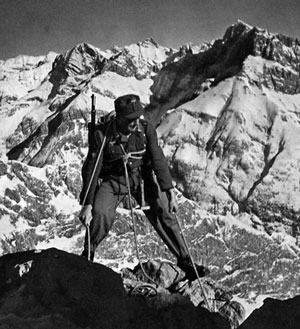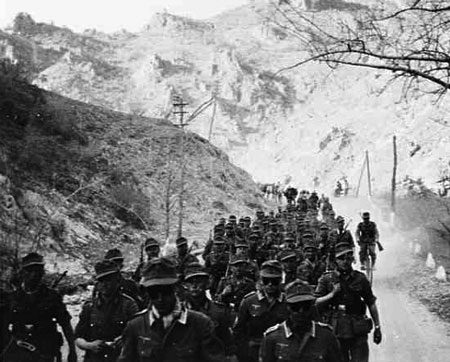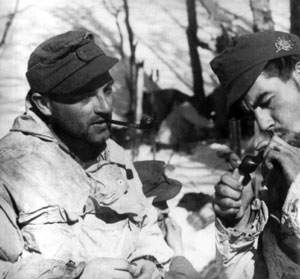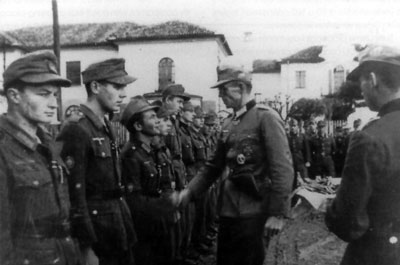
|
| |
|
|
|
|
 |
|
|
5. Gebirgsdivision in Italy 1944-45

|
5. Gebirgsdivision
in Italy
The 5. Gebirgsdivision was formed in 1940 from the 100. Gebirgs Regiment from the 1. Gebirgsdivision and the 85. Infanterie Regiment of the 10. Infanteriedivision. The remaining units of the division came from both the 1. Gebirgsdivision and 10. Infanteriedivision.
The new division underwent its initial training in the Bavarian Alps. Their home base became Salzburg, Austria, however its personnel were mainly recruited from Bavaria.
|
|
Commanders
From the division’s creation in 1940 until 1944 their commander was Generalleutnant Julius “Papa” Ringel. He was awarded the Knight’s Cross on 13 June
1941 for his successful leadership of the division during the invasion
of Greece and Crete.
On 1 December 1942, while the division was in Russia, he was promoted from Generalmajor to Generalleutnant. On 25 October 1943 he was distinguished for his leadership in the northern section with oak leaves added to his Knight’s Cross. On 1 April 1944 he became commander of the LXIX Armee Korps and on 1 June 1944 overall commander of all German mountain troops.
Ringel’s replacement as commander of the 5. Gebirgsdivision from April 1944 was Generalmajor (later Generalleutnant) Max-Gunther Schrank who commanded the division on the Gustav and Gothic lines until January 1945. The final commander of the 5. Gebirgsdivision (18 January 1945 - 8 May 1945) was Generalmajor Hans Steets.
|

Julius “Papa” Ringel.
|
Early Campaigns
The 5. Gebirgsdivision first saw combat in March 1941 when they were
sent to the Balkans to take part in the Greek campaign. They advanced
from Bulgaria into Greece where they first broke through the Metaxas
defence lines after much hard fighting. |
|

5. Gebirgsjäger marching through the Bulgarian mountains to the Greek frontier.
|
The determined Greek troops fought tenaciously, often forcing the Gebirgsjäger to take parts of the line pillbox by pillbox. Even after the final defences had been secured the Greeks would often launch ferocious counter-attacks to push the Gebirgsjäger off.
Finally after four days of fighting the Metaxas line was secured. They took part in further fighting at Belaschiza before they finally marched through Salonika to Athens driving the retreating Greek and Commonwealth forces before them.
Their next role was as an airlanding force to reinforce the
Fallschirmjäger on the Island of Crete. Initially the division was to
arrive by sea from Greece, but the mixed flotilla of improvised
transport vessels was intercepted by the British Navy. The warships
wreaked havoc on the small wooden fishing boats transporting the
Gebirgsjäger.
|
| Finally on 22 May 1941 the III./100. Gebirgsjäger Regiment landed on Maleme airstrip, which had been seized by the paratroopers, in JU-52 transport planes. A combined Gebirgsjäger-Fallschirmjäger force secured the remainder of the airfield and surrounding area. A Gebirgsjäger force was dispatched to clear the surrounding hill of New Zealand troops. After a day of heavy fighting the Gebirgsjäger were able to push the New Zealanders back and take the high ground. Fighting continued until 31 May when the British and Commonwealth troops not evacuated were forced to surrender. The Gebirgsjäger played a great role in completing the Fallschirmjägers’ hard won victory on the island. |
|
Russia
From late Summer 1941 to March 1942 the division retired to Germany to be refitted and rested. They next returned to battle on the Eastern Front with Heersgruppe Nord. They fought in the Volkhov region on the Leningrad front. Initially they were deployed around the River Volkhov to prevent the escape of Soviet units from the Volkhov pocket. During this time the division was used as a “fire brigade” for the 18. Armee. They fought with the I, XXVI, XXVII, XXX, L and LIV Korps during their twenty months on the front.
Italy
In December 1943 the division transferred to Italy under the 10. Armee. They took part in the fighting retreat up the Italian mainland. The fighting withdrawal halted on the Gustav Line where the 5. Gebirgsdivision fought in defence of the Rapido river line and Monte Cifalco.
They were part of the LI Gebirgs Korps consisting of 5. Gebirgsdivision, 1. Fallschirmjäger and 44. Infanteriedivision. The Korps stretched in a line across the Apennines to Cassino and the Liri River. During the defence of the Cassino sector they faced various Allied troops including the New Zealanders once again as well as British, French, Poles, Italians and South Africans.
|

Gebirgsjäger armed with a
StG44 assault rifle.
|
|

Gebirgsjäger take a break.
|
The 5. Gebirgsdivision arrived on the Gustav line just as the French Expeditionary Corps attacked their sector as part of the US 5th Army’s offensive in January 1944. After being caught initially on the back foot, they soon steadied their line on the fortifications of the Gustav line proper. Here they faced the French North African troops who were equally at home in the rugged mountain terrain. The fighting was bitter and protracted, often involving small unit actions amongst the rocks and bushes surrounding the German positions. The stubborn defence of the Gebirgsjäger held true. The defensive advantage they held soon blunted the reckless bravery of the Tirailleurs and the attacks had halted by 17 January. US 5th Army commander, General Mark Clark, refused to support the French attacks with a further division from his US forces and no further progress was made.
The Gebirgsjäger and other troops were sorely stretched and XIV Panzer Korps commander Generalleutnant Fridolin von Senger was concerned that any further pressure in the sector might break through. However Clark’s refusal to reinforce the French brought an end to the immediate threat.
|
|
The 5. Gebirgsdivision was next in action in
the defence of Monte Cifalco, once more defending against the French.
The wily French commander General Juin side stepped the defenders with
the 3rd Algerian Division and moved against Monte Belvedere. Bitter
fighting ensued and the tenacious defence slowed the French before their
objective. Once again the French were refused further support by
General Clark and the attack ground to a halt.
During the US II Corps attack north of Cassino
in late January the left flank positions of the 5. Gebirgsdivision were
engaged by the US 135th Infantry Regiment, but the 44. Infanteriedivision
bore the brunt of the unsuccessful attack.
During the second and third battles of Cassino the 5. Gebirgsdivision was not heavily involved in the fighting.
The next major Allied offensive to face the 5. Gebirgsdivision occurred in May. Operation Diadem started on 11 May. Once again the 5. Gebirgsdivision was caught re-deploying when the offensive begun as they were taking over sectors of the 44. Infanteriedivision, which was being withdrawn from the line.
|

Gebirgsjäger wait for the
next attack.
|
|
The division, now deployed on the left flank of the 1.
Fallschirmdivision, faced the onslaught of the II Polish Corps. The men
of the 100. Gebirgsjäger Regiment went into action, adding their
firepower to the hail of fire put out by the Fallschirmjäger against
the Poles as they made their way up the rock-strewn hillside.
The initial attack by the Poles was halted, but advances by British and
French troops threatened to cut off the German defenders.
|
|

Obersleutnant Richard Ernst, commander of the 100. Gebirgsjäger
Regiment congradulates his troops.
|
On 16 May the
Poles were ready once more to storm the German positions around the
Monte Cassino monastery. The Germans continued to defend skilfully, but
the pressure from in front and the threat on the flank forced them to
withdraw on 18 May.
The breakthrough of the Gustav line and the failure of the Hitler line forced the Gebirgsjäger to conduct a fighting withdrawal until new defensive positions were established on the Gothic Line.
After retreating to the Gothic line they took up positions in the hills to the west of Rimini. The division transferred to the Ligurian Army in August 1944.
|
|
The 5. Gebirgsdivision has the distinction of
being the last German mountain division to fight in high alpine terrain
after being transferred to the Western Alps on the Italian-French
border in 1945. On 20 April seven Gebirgsjäger climbed up the northeast
face of Roc Belleface.
Their daring raid took the French garrison by
surprise and the Germans were able to take the position. After some
further fighting the division assembled and withdrew from their
positions to march towards Milan and surrender. However fighting
continued as Partisans harassed them on their journey.
The division eventually surrendered to the Americans in the town of Ivrea, north of Turin.
The Intelligence Briefing for the 5. Gebirgsdivision can be found in Fortress Italy.
Updated 12 August 2014.
|
Last Updated On Tuesday, August 12, 2014 by Wayne at Battlefront
|
|
|